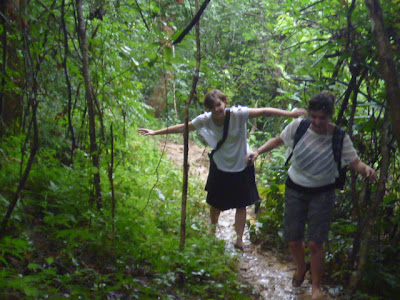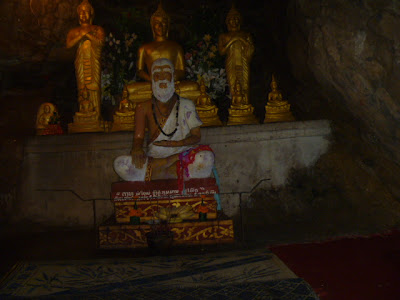Upon my arrival in Bangkok after a brutal 12 hour train ride which might have been pleasant were it not for my extreme stomach pains and constant trips to the bathroom, we settled in the Atlanta Hotel, located in the heart of Bangkok’s metropolis. Immediately upon entering the Atlanta, I knew I was in a place I would visit again. The hotel is a fierce sponsor of the arts, and proud to be so. In the hotel’s restaurant, there is a small library where guests can participate in a book exchange. People from all over the world, for the past sixty years, have passed trough the hotel and left a book behind, while appropriating one from someone else, perhaps from another country, perhaps from another time. I was vexed that I did not have a book to participate in the exchange, given that the only book I brought with me to Laos was borrowed. I went to see a jovial looking old Westerner sitting behind a desk surrounded by books, thinking he must be the hotel’s librarian. I asked him if I could perhaps rent a book, since I did not have one to give in exchange. He smiled at me and said in a nice British accent, “you don’t really have to leave one, just take one if you find one that pleases you.” I thanked him and was about to turn to the selection when he seemed to take a sudden interest in me and asked, “what language do you read in?” “English” I answered. He then asked me when I was set to leave the hotel, and when I told him my flight to Paris left the following evening he seemed a bit vexed before finally telling me, “you see, I have a personal collection of English books, and I could lend you a great book of non-fiction if you are interested, but you must promise to return it.” Knowing this would be no problem because for one I am a fast reader and for two I was sick and would be spending my entire two days in Bangkok in bed, I told him I promised to do so. Five minutes later he returned with Thomas Keneally’s memoir, Searching for Schindler. I was familiar with Schindler’s Arc, but I had never read the book, nor had I seen Schindler’s List, Steven Speilburg’s movie adaptation. Nonetheless, I was intrigued by the book and very appreciative of the loan.
I returned to my hotel room and began to read Keneally’s story of how he came to know the now legendary story of Oskar Schindler. From this book I got a glimpse of the character of Schindler and I knew at once that I simply had to read Schindler’s Arc. I sent an e-mail to my father asking him to pick up a copy, so that I could begin my reading upon my arrival in Canada.
Unlike Keneally, I wasn’t really fascinated by the seeming duplicity of Schindler’s character, both “sinner” and “saint”. The conundrum that captivated Keneally was to me mere humanity. Perhaps because he had a Catholic upbringing and I had very much the opposite, I was never one to think that a person’s indulgence in liquor, food, or sex was a factor in determining whether or not they were a genuinely good person. To me, compassion was the decisive factor, and compassion Schindler possessed. I was more fascinated by the courage and absolute conviction in his belief’s that it took for this man to risk his life for the benefit of others during so strict and terrifying a regime. Compassion aside, the Nazi regime was a powerful propaganda machine that succeeded in convincing the minds of countless educated and cultured people that “racial cleansing” was not immoral but for the better of mankind. Something inside of Schindler was able to push aside the overbearing message of the media and belief of his time, and see the people whom he saved for the individuals that they were. Not as one of the countless Jews that were doomed to death, not as a nameless face to be used and thrown away, not as a lesser being under his power, but as a human. As someone’s mother, father, son or daughter, standing in front of him starving and suffering, and whom it was within his power to help.
I remember visiting the Holocaust Museum in Montreal when I first moved there. The museum was memorable because it gave me a new perspective on the Holocaust. Aside from the accounts of the terrible deaths and atrocities that occurred during the Holocaust, which I was already familiar with, the museum also offered a glimpse into the propaganda and use of media that allowed Hitler to convince a nation, an entire nation, that Jews did not deserve to live. I remember seeing the posters and hearing translated versions of what had once been spoken on the radio or television. After my visit, I remember the strange and scary feeling that accompanied the thought, “he made it seem so justified.” As a child, I was haunted by the mystery as to how so many people could watch human suffering and not do anything to help. My young mind could not contemplate how so many people could partake in such atrocities. I have since learned that human nature is a mysterious thing. A story like Schindler’s would have most certainly been received by my young self as an account of the ordinary, a normal reaction any human would have in his situation. As an adult, I am fascinated that a man did not succumb to the immense temptation that power offers to anyone: abuse.























